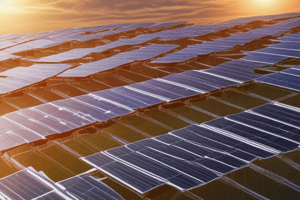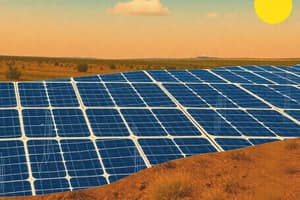Podcast
Questions and Answers
Which of the following best describes how solar cells convert solar energy into electrical energy?
Which of the following best describes how solar cells convert solar energy into electrical energy?
- By reflecting sunlight onto a central collector.
- Using semiconductors to directly convert sunlight into electricity. (correct)
- Through chemical reactions that release electrons.
- By heating water to create steam that turns a turbine.
The efficiency of a solar cell is solely determined by the materials used and is not affected by external factors such as weather conditions.
The efficiency of a solar cell is solely determined by the materials used and is not affected by external factors such as weather conditions.
False (B)
What is the primary function of wind turbines in generating electricity?
What is the primary function of wind turbines in generating electricity?
convert kinetic energy into electrical energy
In hydroelectric power generation, dams are used to store water, which gains ________ energy due to its position.
In hydroelectric power generation, dams are used to store water, which gains ________ energy due to its position.
Match the following renewable energy sources with their primary method of electricity generation:
Match the following renewable energy sources with their primary method of electricity generation:
Which environmental factor does NOT directly impact the efficiency of solar cells?
Which environmental factor does NOT directly impact the efficiency of solar cells?
Solar heaters are characterized by low efficiency when used to heat water.
Solar heaters are characterized by low efficiency when used to heat water.
What is the role of semiconductors in the operation of solar cells?
What is the role of semiconductors in the operation of solar cells?
The Benban Station in Aswan is considered the capital of ________ energy.
The Benban Station in Aswan is considered the capital of ________ energy.
Match each application with the correct renewable energy source:
Match each application with the correct renewable energy source:
What best describes the function of the anti-reflection coating in a solar cell?
What best describes the function of the anti-reflection coating in a solar cell?
Hydroelectric power plants are most effective in areas with low altitude and minimal water flow.
Hydroelectric power plants are most effective in areas with low altitude and minimal water flow.
What is the unit of measurement for electrical power, which also represents energy produced or consumed per second?
What is the unit of measurement for electrical power, which also represents energy produced or consumed per second?
The operation of wind turbines relies on the ________ of air.
The operation of wind turbines relies on the ________ of air.
Match the following components of a wind turbine with their function:
Match the following components of a wind turbine with their function:
What is the primary reason solar-powered air conditioners are beneficial for residents in hot countries?
What is the primary reason solar-powered air conditioners are beneficial for residents in hot countries?
The efficiency of a solar cell can reach 100% in practical applications.
The efficiency of a solar cell can reach 100% in practical applications.
What is the formula to calculate electrical power (P) if you know the voltage (V) and current (I)?
What is the formula to calculate electrical power (P) if you know the voltage (V) and current (I)?
Nanotechnology improves solar cell efficiency by enhancing the ability to absorb ________.
Nanotechnology improves solar cell efficiency by enhancing the ability to absorb ________.
Match the following terms with their definitions related to solar cells:
Match the following terms with their definitions related to solar cells:
Flashcards
Renewable Energy
Renewable Energy
Energy sources that can be replenished naturally, like solar and wind power.
Solar Cells
Solar Cells
Devices that convert solar energy directly into electrical energy using semiconductors, preserving the environment and minimizing pollution.
How Solar Cells Work
How Solar Cells Work
When light hits silicon, photons displace electrons, creating a potential difference and electric current if connected to a circuit.
Efficiency of a Solar Cell
Efficiency of a Solar Cell
Signup and view all the flashcards
Improving Solar Cell Efficiency
Improving Solar Cell Efficiency
Signup and view all the flashcards
Electrical Energy Equation
Electrical Energy Equation
Signup and view all the flashcards
Electrical Power Equation
Electrical Power Equation
Signup and view all the flashcards
Solar Heaters
Solar Heaters
Signup and view all the flashcards
Solar Air Conditioners
Solar Air Conditioners
Signup and view all the flashcards
Solar Lamps
Solar Lamps
Signup and view all the flashcards
Wind Energy
Wind Energy
Signup and view all the flashcards
How Wind Turbines Works
How Wind Turbines Works
Signup and view all the flashcards
Wind Turbine Parts
Wind Turbine Parts
Signup and view all the flashcards
Best Place to Build Wind Turbines
Best Place to Build Wind Turbines
Signup and view all the flashcards
Hydroelectric Power
Hydroelectric Power
Signup and view all the flashcards
How Hydroelectric Power Works
How Hydroelectric Power Works
Signup and view all the flashcards
Study Notes
- Renewable energy sources, like solar and wind power, can be harnessed to convert natural energy into usable power, while assessing environmental and climate impacts.
Solar Energy
- Solar cells are made of semiconductors that convert solar energy directly into electrical energy, preserving the environment and minimizing pollution from fossil fuels.
- Benban Station in Aswan, Egypt, is considered the capital of solar energy, comprising 32 stations with a combined capacity of 1465 megawatts.
How Solar Cells Work
- Photons displace electrons on a semiconductor's surface, like silicon, when light hits it.
- A potential difference between the surfaces creates an electric current when connected to an external circuit.
Efficiency of Solar Cells
- Solar cell efficiency is determined by comparing electrical energy produced to the light energy provided by the sun.
- A cell that converts all incident light energy into electrical energy has 100% efficiency.
- In real-world applications, solar cells are not perfect.
- Solar cell electricity generation varies with the sun's angle of inclination.
- Clouds, wind, dust, and humidity affect solar cell electricity generation.
- Nanotechnology improves solar cell efficiency through new materials with a high ability to absorb sunlight.
- Electrical energy (E) in joules: E = V.I.T, where I is current in amperes, V is voltage in volts, and T is time in seconds.
- Power (P) is measured in watts, representing energy produced or consumed per second: P = V.I
- Efficiency of a Solar Cell = (Electric power produced / Optical power falling on the cell) × 100
Daily Use Applications of Solar Cells
- Solar water heaters heat water for various purposes, reducing electricity use and are characterized by high efficiency.
- Solar-powered air conditioners are convenient for residents in hot countries and reduce electricity consumption.
- Solar lamps illuminate and decorate gardens, are alternatives during power outages consuming less electricity.
- Solar lamps have automatic operation, are environmentally friendly, and do not produce exhausts.
Wind Energy
- Wind energy is a crucial environmentally friendly energy source, converting wind energy into clean electrical energy.
How Wind Energy Works
- Wind turbines, with streamlined and curved blades, operate via air movement.
- Air flowing over the blades creates differing atmospheric pressure zones due to varying air speeds, causing movement.
- Turbine blades connect to a generator via a transmission shaft, converting kinetic energy into electrical energy.
Efficiency of Wind Turbines
- Wind turbine efficiency depends on wind speed and is preferable in open areas like deserts and high altitudes.
Hydroelectric Power
- Hydroelectric power generates electricity from the energy of flowing or falling water.
How Hydroelectric Power Works
- Dams store water in reservoirs, giving it potential energy and use gates to control water movement.
- Opening the gates releases water from upstream to downstream, turning turbines.
- This movement is transmitted to electrical generators, converting the energy into electrical energy.
Studying That Suits You
Use AI to generate personalized quizzes and flashcards to suit your learning preferences.




